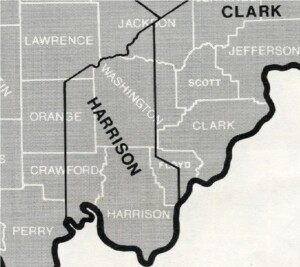
Image from Map Guide to the U.S. Federal Censuses, 1800-1920 by William Thorndale and William Dollarhide.
This year is the Floyd County Bicentennial, meaning that Floyd County is two hundred years old! It was established in 1819 and created from part of Harrison County and part of Clark County. The black line in the above picture, which shows the county line between Harrison and Clark counties, is approximately where Grant Line Road is today. It is so named because Clark’s Grant, land given to the men who fought under George Rogers Clark’s leadership, where granted land in Clark County that extended to that line. The namesake for Floyd County has been widely debated over the years, but is now commonly believed to Davis Floyd, who was the Floyd County Circuit Court Judge.
Prior to the settlement of this area, what is now Floyd County was part of the hunting ground from the Shawnee, Piankeshaw, Wyandotte, and Delaware tribes. Early settlers of Floyd County included Belgian, English, French, German, Irish, and Swiss. Floyd County was also part of the Underground Railroad, and by the end of the Civil War, had the largest population of African Americans in Indiana.
Franklin Township was settled in 1804.
Georgetown was settled in 1807 and established in 1836.
New Albany was established in 1813 and became the county seat. It was settled at least as early as 1809.
Scottsville was settled in 1812 and established in 1853.
Greenville was established in 1816.
Lafayette Township was formed from part of Greenville in 1828.
Germantown was also established in 1836 and became Galena in 1860.
Mooresville was settled in the late 1830s and became Floyds Knobs in 1852.
Edwardsville was established in 1853.
Floyd County has been home to notable politicians, such as Michael C. Kerr, and to Sherman Minton, a Supreme Court Justice. Floyd County is also the home of eminent artists and authors, such as William Vaughn Moody, Ferdinand Graham Walker, and George W. Morrison. Floyd County native Emma Nunemacher Carleton was a poet and columnist for both local and Indianapolis newspapers. Byron Forcythe Willson was another poet from Floyd County. His poem, “The Old Sargeant,” is nationally known, as it was circulated to all Union troops during the Civil War. These are just a few of Floyd County’s prominent citizens!
Floyd County has had many thriving industries over the years. While we are primarily agricultural, mills, shipbuilding, tanneries, glass works, brick works, and many other industries have also been a big part of our history. The history of Floyd County is too vast to write it all here, but there is much more to be found in the Library’s Indiana History Room!

